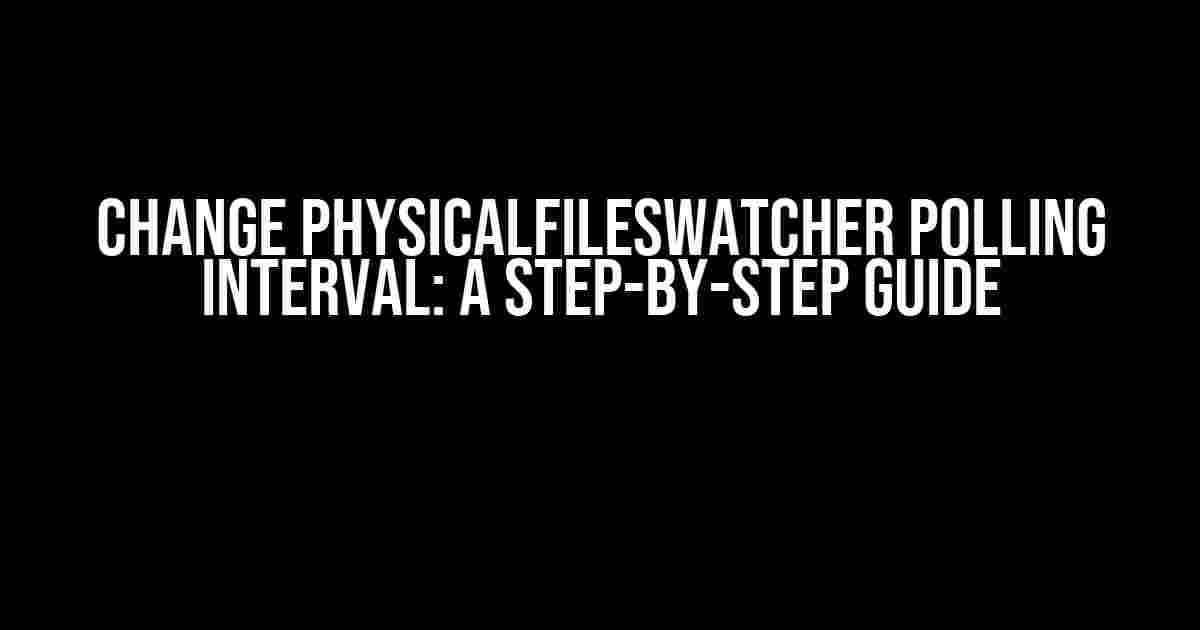Are you tired of the default polling interval of the PhysicalFilesWatcher affecting the performance of your application? Do you want to know how to change it to optimize your file watching experience? Look no further! In this comprehensive guide, we’ll take you through the process of changing the PhysicalFilesWatcher polling interval, explaining each step in detail and providing you with the necessary code snippets to get you started.
Understanding PhysicalFilesWatcher
Before we dive into the process of changing the polling interval, let’s quickly understand what PhysicalFilesWatcher is and how it works. PhysicalFilesWatcher is a .NET class that allows you to monitor file system changes, such as file creations, deletions, and modifications. It’s an essential component of many applications, especially those that require real-time file monitoring.
The PhysicalFilesWatcher works by polling the file system at regular intervals to detect changes. This polling interval is set by default to 10 seconds, which might not be suitable for all applications. If you need a more frequent or less frequent polling interval, you’ll need to change it manually.
Why Change the Polling Interval?
So, why would you want to change the PhysicalFilesWatcher polling interval? Here are a few reasons:
- Performance optimization**: If your application requires real-time file monitoring, you might want to increase the polling frequency to detect changes more quickly. On the other hand, if your application is resource-intensive, you might want to decrease the polling frequency to reduce the load on your system.
- Customization**: Depending on your application’s requirements, you might need a polling interval that’s tailored to your specific needs. Changing the polling interval allows you to customize the PhysicalFilesWatcher to fit your application’s unique requirements.
- Error handling**: If you’re experiencing errors due to the default polling interval, changing it might help resolve those issues.
Changing the Polling Interval
Now that we’ve covered the why, let’s get to the how! Changing the PhysicalFilesWatcher polling interval involves creating a new instance of the FileSystemWatcher class and setting the InternalBufferSize property.
using System.IO; // Create a new instance of the FileSystemWatcher class FileSystemWatcher watcher = new FileSystemWatcher(); // Set the polling interval to 5 seconds (5000 milliseconds) watcher.InternalBufferSize = 5000;
In the code snippet above, we’ve created a new instance of the FileSystemWatcher class and set the InternalBufferSize property to 5000 milliseconds, which is equivalent to 5 seconds. This will change the polling interval from the default 10 seconds to 5 seconds.
Understanding the InternalBufferSize Property
The InternalBufferSize property is a bit tricky to understand, but don’t worry, we’ve got you covered! The InternalBufferSize property is used to set the buffer size, in bytes, for the internal buffer that stores file system changes. When the buffer reaches its capacity, the PhysicalFilesWatcher will process the changes and raise the relevant events.
However, what’s important to note is that the InternalBufferSize property also affects the polling interval. When you set the InternalBufferSize property, you’re indirectly setting the polling interval. A larger buffer size means a longer polling interval, while a smaller buffer size means a shorter polling interval.
Here’s a rough estimate of the polling interval based on the InternalBufferSize property:
| InternalBufferSize (bytes) | Polling Interval (seconds) |
|---|---|
| 1024 | 1 |
| 2048 | 2 |
| 4096 | 4 |
| 8192 | 8 |
Best Practices for Changing the Polling Interval
When changing the PhysicalFilesWatcher polling interval, keep the following best practices in mind:
- Set a reasonable buffer size**: Avoid setting the InternalBufferSize property to extremely large or small values, as this can affect performance and accuracy.
- Test and iterate**: Test your application with different polling intervals to find the sweet spot that balances performance and accuracy.
- Monitor system resources**: Keep an eye on system resources, such as CPU and memory usage, to ensure that changing the polling interval doesn’t negatively impact your system.
- Consider the file system load**: If your file system is heavily loaded, you might want to decrease the polling frequency to avoid overloading the system.
Conclusion
Changing the PhysicalFilesWatcher polling interval is a straightforward process that can significantly impact the performance and accuracy of your application. By understanding how the PhysicalFilesWatcher works and following the best practices outlined in this guide, you can customize the polling interval to fit your application’s unique needs.
Remember, the key to successful file monitoring is finding the right balance between polling frequency and system resources. Experiment with different polling intervals and monitor your system’s performance to find the optimal setting for your application.
Happy coding!
Frequently Asked Question
Get the lowdown on changing the PhysicalFilesWatcher polling interval – we’ve got the answers you need!
What is the default polling interval for PhysicalFilesWatcher?
By default, PhysicalFilesWatcher polls every 500 milliseconds (0.5 seconds). But hey, you can change it to suit your needs!
How do I change the polling interval for PhysicalFilesWatcher?
Easy peasy! You can change the polling interval by setting the InternalBufferSize property or the PollingInterval property when creating a new instance of PhysicalFilesWatcher.
What’s the recommended polling interval for PhysicalFilesWatcher?
The recommended polling interval depends on your specific use case. If you need to detect changes quickly, a shorter interval (e.g., 100-500 ms) might be best. For less frequent checks, you can set a longer interval (e.g., 1-5 seconds). Experiment to find the sweet spot for your app!
Will changing the polling interval affect system performance?
Yes, changing the polling interval can impact system performance. A shorter interval can lead to increased CPU usage, while a longer interval might result in delayed file change detection. Be mindful of the trade-offs and adjust accordingly!
Can I change the polling interval dynamically at runtime?
Sorry, no can do! The polling interval is set when creating a new instance of PhysicalFilesWatcher and cannot be changed dynamically at runtime. Plan ahead and set the interval that works best for your app!

